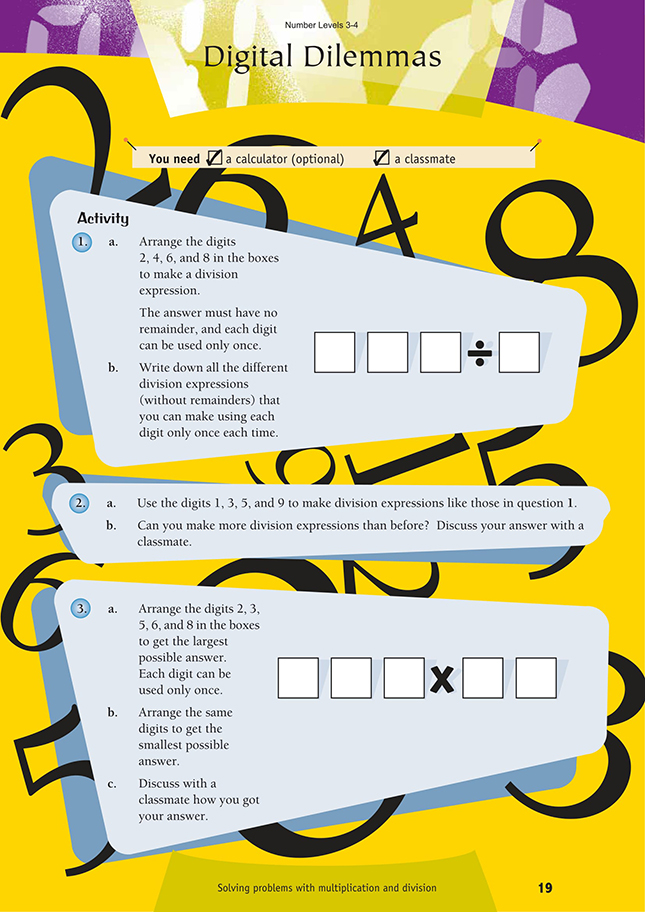This is a level 4 number activity from the Figure It Out series. It relates to Stage 7 of the Number Framework.
A PDF of the student activity is included.
Click on the image to enlarge it. Click again to close. Download PDF (233 KB)
use multiplication and divisibility rules to solve puzzles
A calculator (optional)
FIO, Level 3-4, Number, Book 1, Digital Dilemmas, page 19
A classmate
The students will probably approach these problems by using trial and improvement, but there are several mathematical rules that can be used to solve the problems more efficiently. You could let the students begin working on the problems and, after a short time, discuss with the whole class how they are approaching the problems and whether anyone has found any quick ways to solve them. The more efficient methods are set out below.
Any arrangement of 4, 6, and 8 will be divisible by 2 because each arrangement will be an even number. None of the numbers will be divisible by 6 because to be divisible by 6, the number must be even and divisible by 3. To be divisible by 3, the sum of the digits must be divisible by 3. For example, 2 x 4 + 8 = 16, which is not divisible by 3.
You still need to look at numbers divisible by 4 and 8.
For 4, these could be:
862
826
628
682
286
268
But to be divisible by 4, the number formed by the last two digits must be divisible by 4. The number 28 is divisible by 4, and so is 68, therefore 268 and 628 are divisible by 4. (Any number of hundreds is divisible by 4, for example, 600 ÷ 4 = 6 x 25.)
For 8, the numbers could be:
642
624
462
426
264
246
The rule here is: if the hundreds digit is even and the number formed by the last two digits is divisible by 8, then the number is divisible by 8. This means that only 624 and 264 are correct. (Any even number of hundreds is divisible by 8, for example, 600 ÷ 8 = 3 x 25.)
For question 2a, the rules that apply are:
• All numbers are divisible by 1.
• All numbers whose digits add to a number divisible by 3 are divisible by 3.1 + 5 + 9 = 15, which is divisible by 3, and therefore all numbers made using the digits 1, 5, and 9 will be divisible by 3.
• To check for divisibility by 9, the sum of the digits must be divisible by 9.1 + 3 + 5 = 9, which is divisible by 9, so all combinations of 1, 3, and 5 will be divisible by 9.
• To be divisible by 5, the number must end in 5 or 0, so there are no combinations of 1, 3, and 9 that are divisible by 5.
In question 3, to obtain the largest possible product when two numbers are multiplied, you need to arrange the digits into the largest possible numbers. This means you need 800 x 60 or 600 x 80, with the other digits also arranged in the largest possible ways. The students should try several arrangements of digits to make sure they are getting the highest product.
To find the smallest possible product, you need to arrange the digits into the smallest possible number. Encourage the students to think these issues through so that they can predict which numbers will give the largest products when multiplied together.
Answers to Activity
1. a.–b.
The possible division expressions are:
624 ÷ 8
264 ÷ 8
628 ÷ 4
268 ÷ 4
468 ÷ 2
486 ÷ 2
648 ÷ 2
684 ÷ 2
846 ÷ 2
864 ÷ 2
2. a. 135 ÷ 9
153 ÷ 9
351 ÷ 9
315 ÷ 9
513 ÷ 9
531 ÷ 9
935 ÷ 1
953 ÷ 1
539 ÷ 1
593 ÷ 1
359 ÷ 1
395 ÷ 1
591 ÷ 3
519 ÷ 3
951 ÷ 3
915 ÷ 3
195 ÷ 3
159 ÷ 3
b. Yes. You have more answers because all combinations of the other three digits are
divisible by 1, 3, and 9.
3. a. 652 x 83 = 54 116
b. 368 x 25 = 9 200
c. Answers will vary, but they should focus on organising the digits in either the largest or the smallest possible way and trialling them.
